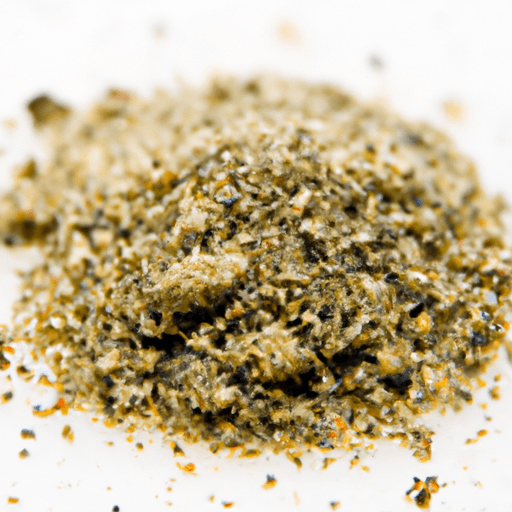The Wonderful World of Poultry Seasoning Blend
If you’ve ever wondered how to add a cozy, nostalgic flavor to your poultry dishes, look no further than the versatile and aromatic poultry seasoning blend. This classic combination of herbs and spices is a must-have for any home cook looking to elevate their poultry game. In this blog post, we will dive into the tantalizing world of poultry seasoning, exploring its taste, common uses, nutritional value, and fascinating history. Get ready to embark on a delicious adventure!
Taste and Aroma
Poultry seasoning is a harmonious blend of herbs and spices carefully selected to complement the natural flavors of poultry. While the exact composition may vary, the star ingredients usually include sage, rosemary, thyme, marjoram, and nutmeg. The combination of these aromatic herbs creates a robust and earthy flavor profile with hints of warmth and a touch of sweetness. The aroma of poultry seasoning alone can transport you to a cozy kitchen on a chilly autumn evening.
Common Uses in Cooking
Poultry seasoning is a true culinary workhorse, infusing poultry dishes with depth and character. Its most common use is in a Thanksgiving favorite, roast turkey. Sprinkling poultry seasoning over the bird before roasting adds a delightful herbaceous note that complements the meat perfectly. But poultry seasoning doesn’t stop at turkey; it can also be used to enhance the flavors of roast chicken, game birds, stuffing, and even vegetarian dishes like roasted vegetables or grain-based dishes.
Nutritional Value
Aside from its remarkable flavor, poultry seasoning also contains various nutritional benefits. Sage, a prominent ingredient in the blend, is known for its antioxidant properties and is believed to aid digestion. Thyme, another key component, is rich in vitamins C and A, as well as minerals like iron and manganese. Additionally, rosemary in poultry seasoning has been praised for its anti-inflammatory properties. While the quantities used in seasoning are typically small, every pinch adds a sprinkle of goodness to your dishes.
History and Fun Facts
The origins of poultry seasoning can be traced back to traditional European herb blends, often used to enhance the flavors of roasted meats. In the United States, poultry seasoning has become closely associated with Thanksgiving and holiday feasts. Its popularity skyrocketed during the 19th century when traditional European flavors melded with American cooking techniques. Today, no Thanksgiving feast is complete without the comforting aroma of poultry seasoning wafting through the kitchen.
Fun fact: Did you know that some poultry seasoning blends may also include dried parsley, onion powder, or garlic powder, depending on personal preferences and regional variations? Experimenting with different combinations allows home cooks to create their unique twist on this beloved blend.
Poultry seasoning is a delightful addition to any kitchen pantry, offering a delightful combination of flavors that elevate poultry dishes to new heights. Its robust and earthy taste, along with its rich aromatic profile, make it a go-to choice for creating comforting meals reminiscent of home. Whether you’re preparing a traditional Thanksgiving turkey or adding a burst of flavor to everyday chicken recipes, poultry seasoning is a versatile and invaluable ally in your culinary adventures. So go ahead, sprinkle it liberally and savor the results!
- Poultry seasoning blend is a traditional spice mix commonly used in American and Canadian cuisine.
- The exact origin of poultry seasoning is unclear, but it is believed to have originated in the United States in the 19th century.
- Poultry seasoning is primarily composed of a combination of dried herbs and spices, including sage, thyme, marjoram, rosemary, and sometimes nutmeg or celery seed.
- The name “poultry seasoning” suggests that it is primarily used for seasoning poultry, such as chicken and turkey. However, it can also be used to flavor other meats, stuffing, gravies, and vegetable dishes.
- Poultry seasoning blend is known for its aromatic and earthy flavors, which enhance the taste of poultry dishes and complement other ingredients.
- Sage is considered the dominant flavor in poultry seasoning, imparting a savory and slightly peppery taste.
- Thyme and rosemary contribute to the herbaceous and slightly pine-like undertones of poultry seasoning.
- Marjoram adds a delicate floral note, while nutmeg provides a warm and slightly sweet flavor.
- Celery seed, when included, adds a subtle celery-like taste.
- Poultry seasoning is often used to recreate the traditional flavors of holiday dishes, such as Thanksgiving turkey and stuffing.
- Aside from its culinary uses, poultry seasoning does not have significant nutritional benefits, as it is typically used in small amounts.
- Poultry seasoning is readily available in most grocery stores, but it can also be made at home by combining the individual dried herbs and spices in the desired proportions.




Use the share button below if you liked it.
It makes me smile, when I see it.